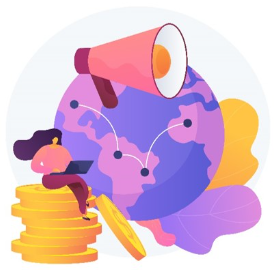 Introduction. What is a business model? Introduction. What is a business model?
Business model Click to read Click to read
|
A business model is a conceptual tool used to describe the way in which a company creates, distributes and captures value. (Osterwalder, 2005)
The term business model refers to a company's strategic plan for making a profit.
It can be defined as the set of organizational practices and strategic solutions through which the company seeks to gain a competitive advantage in the market. It must be flexible and dynamic.
|
 |
Canvas business model Click to read Click to read
Business model’s elements Click to read Click to read
Summing up Click to read Click to read
| Summing up |
 |
“Business model” refers to a company's strategic plan for making a profit |
|
 |
The business model must be flexible and dynamic to be efficient |
|
 |
The Business model canvas can graphically represent the business model |
| |
|
|
|
|
|
|
|
 |
A business model is composed of 9 constituent elements |
|
 Digital business models and classifications Digital business models and classifications
Digital business models’ characteristics Click to read Click to read
 |
The value proposition of the offered service is created using digital technologies |
 |
The customer acquisition and the product or service distribution are based on digital channels |
 |
Culture is usually less hierarchical due to the ability to (digitally) communicate more easily and quickly |
 |
Digitalization promotes innovation, giving employees tools and opportunities to have and develop new ideas |
 |
Digital business transactions provides data which can be analyzed and exploit to make improvements |
 |
Productivity is constantly increased by automating processes |
 |
Digital data lead to a customer-centric approach |
Types of digital business model Click to read Click to read
 |
Free-model |
This type of model offers a free service and derives profit through the customer and not from the customer, for example, by selling advertising space on the platform. |
 |
 |
 |
Freemium model |
In this case, users can take advantage of a basic, free version of the product or service, but can at any time subscribe or buy a premium, paid version. |
 |
 |
Marketplace model (Two-sided marketplace) |
It is a similar model to the previous one, but can include both products and services; two-sided: the company can sell products (or services) of a 3rd party. The E-Commerce model is the one-sided version of this model: the company sells its own (physical) products. |
 |
 |
 |
Experience model |
This model involves adding a digital experience to the product on sale. |
 |
 |
Ecosystem model |
Ecosystem orchestrators, like Amazon and Google, are those companies that offer customers different services on different platforms; this model also includes those companies that use or supply the ecosystem. |
 |
 |
 |
Subscription model |
The use of the service offered by the company requires a subscription on the part of the customer (monthly, annual, etc.). |
 |
 |
On-Demand model |
This system allows the customer to pay to “rent” or use a virtual product or a service for a certain amount of time. |
 |
 |
Access-Over-Ownership model |
Similar to the previous one, but, in this case, you pay for a physical product (like renting a car or an apartment). |
 |
Summing up Click to read Click to read
| Summing up |
 |
A digital business model is based on digital technologies and channels |
|
 |
The corporate culture is less hierarchical and promote innovation |
|
 |
There are several types of digital business models from which you can choose |
| |
|
|
|
|
|
|
|
 |
It is also possible to mix different business models’ types |
|
 Internationalization. Internationalization.
The process of internationalization Click to read Click to read
| Internationalization is that process of commercial expansion that aims to broaden a company's operational horizons and expand its presence beyond its national borders. |
|
It is therefore the possibility of seeking and exploiting markets outside the national context to make more profit from the sale of goods and services.
Expanding a business to a foreign market can be hindered by different technical or cultural factors: thorough prior research is essential.
|
 |
Opportunities and risks of internationalization Click to read Click to read
In today's globalized and digitized market, there are fewer obstacles to internationalization than in the past. The possibilities of access to foreign markets have also increased for small and medium-sized enterprises. Opening up to international markets can benefit both companies with good and poor national performance.
In the first case, instead of facing national competition from stronger companies, one can look for new markets with greater possibilities for growth. In the second case, on the other hand, in addition to increased revenues due to international presence, benefits also arise from increased visibility in the national market and customer fidelization.
 Country risk: the geopolitical situation of foreign states (possible internal tensions may destabilize trade policies) and the different regulatory framework; Country risk: the geopolitical situation of foreign states (possible internal tensions may destabilize trade policies) and the different regulatory framework;
 Technical risk: the specific characteristics of the product may not comply with current regulations or may not be suitable in other territories (for example, different types of sockets); Technical risk: the specific characteristics of the product may not comply with current regulations or may not be suitable in other territories (for example, different types of sockets);
 Market risk: the need to adapt products to the new market and customer demands. Market risk: the need to adapt products to the new market and customer demands.
|
These risks can be minimized by careful research prior to business expansion into the foreign market and good strategic planning.
In particular, one should find out about the political situation, the laws of the country and the lifestyle, habits and culture of the population.
|
 |
Internationalization strategies: product customization Click to read Click to read
| Internationalization strategies can be classified according to the level of product customization and according to the type of foreign presence of the company. |
1) Multi-domestic strategy: the company customizes its product and service offering for each country in which it operates (this requires in-depth knowledge of the local market).
2) Global strategy: the company offers the same product or service in all the countries in which it operates, exploiting economies of scale to have a low-cost structure strategy. |
| 3) Transnational strategy: the company implements slight modifications to products in different countries, but exploiting economies of scale; it is a middle way between the multi-domestic and the global strategy. |
 |
| Internationalization strategies can be classified according to the level of product customization and according to the type of foreign presence of the company. |
|
 Exportation: the export of products can be Exportation: the export of products can be
- indirect → when the company takes its products abroad via third-party companies;
- direct → when the company is responsible for exporting its own products.
Responsibility for exporting also involves taking care of all the bureaucratic and legal paperwork, finding customers and managing the marketing campaign in the new market.
|
|
 Establish a production point: settling in the new country in this way can be particularly complex and expensive, but it generates more benefits in the long run. Establish a production point: settling in the new country in this way can be particularly complex and expensive, but it generates more benefits in the long run.
 Contractual Agreements: these are based on contracts and agreements with companies in other countries in order to bring the brand to the new country and target market. These agreements can be: Contractual Agreements: these are based on contracts and agreements with companies in other countries in order to bring the brand to the new country and target market. These agreements can be:
- licenses → the licensing company grants rights such as trademarks and production and marketing permits;
- international franchises → the franchising company grants already established production and marketing systems.
 Direct investment: setting up subsidiaries abroad so that you can establish yourself in the target country without resorting to agreements with foreign partners. Direct investment: setting up subsidiaries abroad so that you can establish yourself in the target country without resorting to agreements with foreign partners.
|
 |
Summing up Click to read Click to read
| Summing up |
 |
Internationalization is a process of commercial expansion |
|
 |
Today there are fewer obstacles to internationalization than in the past |
|
 |
The risks can be minimized by careful research and good strategic planning |
| |
|
|
|
|
|
|
|
 |
There are different types of internationalization strategies |
|
 Recommendations and Tips. Do’s and Don’ts Recommendations and Tips. Do’s and Don’ts
General tips Click to read Click to read
Do’s and Don’ts Click to read Click to read
Summing up Click to read Click to read
| Summing up |
 |
It is advisable to research, study the competition and be flexible |
|
|
 Business models in international digital marketing
Business models in international digital marketing


 Introduction. What is a business model?
Introduction. What is a business model? Click to read
Click to read 





























